Introduction The month of June presented the unit with new challenges from the non-traditional areas of Amboseli and Shimba hills with Tsavo being relatively calm
Introduction The month of June presented the unit with new challenges from the non-traditional areas of Amboseli and Shimba hills with Tsavo being relatively calm. Snares overtook arrows in terms of causative agents. The region still remains dry, a condition expected to continue until the November short rains. Cases handled included limb amputation of an elephant calf in Amboseli and snared Elephant in Shimba hills.
Treatment of an injured Elephant bull in Amboseli National Park, 1st June The Elephant was sighted limping towards the oldare swamp with a suspected right front limb spear injury. Darting was done using 18 mgs of etoprhine and in a dan inject dart system. The injury suspected caused by spear was cleaned using hydrogen peroxide and water and later doused with tincture of iodine. The injury affected the ankle joint and prognosis is guarded.
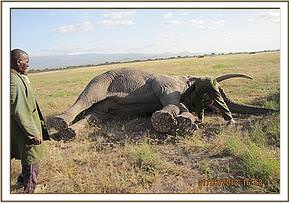
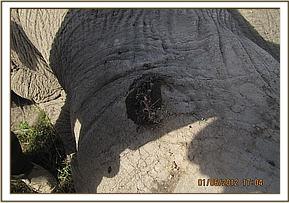
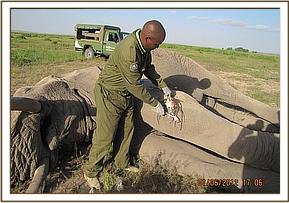

Treatment of an Elephant calf with amputated limb in Amboseli, 2nd June. The Elephant calf with amputated limb was sighted in the swamps of Amboseli limping on three legs. He was accompanied by family members who were not resident to Amboseli but thought to have migrated from Mt. Kilimanjaro. The limb was completely amputated by suspected wire snare leaving the suffering calf to walk on three limps. Due the risk of attack from the mother, both the calf and the mother had to be darted. The mother was darted with 16 mgs of etorphine and went down in 6 minutes while the calf was anaesthetized using 3 mgs of etorphine. The mother was monitored as the calf was treated. Several hanging tissues were cut off and the wound cleaned using water/ hydrogen peroxide mixture and doused with iodine, sprayed with Oxytetracycline spray and a final coat of green clay applied.
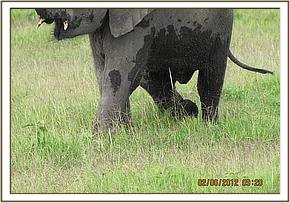
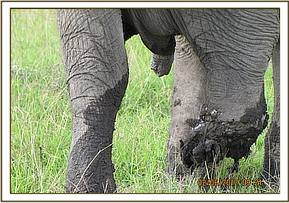
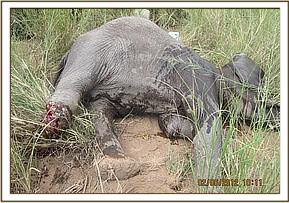

Treatment of a snared Elephant in Shimba hills National reserve, Kwale; 3rd June Shimba hills has witnessed an increase in cases of snaring, but the hilly terrain and thick forests make follow up a huge task. After several hours of searching for an injured elephant another was reported in a different area bearing a tight snare on the limb. Darting was done using 16 mgs of etoprhine propelled in a dan inject darting system. A tight snare made from a tough cable wire was cut loss, the wounds washed clean, disinfected, and anti-bacterials applied. A final coat of green clay was applied. Another wound was treated at the ventral abdomen.
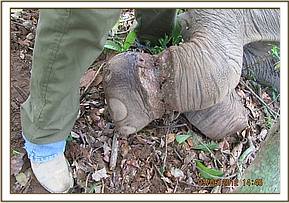
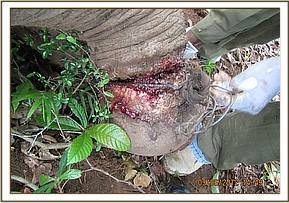



Partial castration of a lion with testicular injury in Taita hills sanctuary, 6th June. A case of an injured pride male was reported in Taita sanctuary area with a testicular injury where right testicle scrotum was opened by unknown cause and the tunica vaginalis exposed and swollen. The affected testicle was removed and spermatic cord clipped. The lion was immobilized by using 300 mgs of ketamine and 3.75 mgs of meditomidine. Two top ups of ketamine were administered after previous anesthesia got lighter. The operation took about 30 minutes after which the Lion was revived to join the pride. He is expected to maintain his status as a pride male and breeding capability.
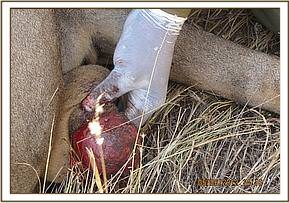
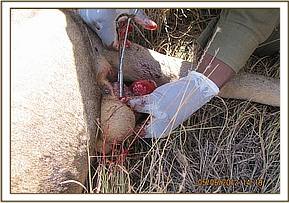

Rescue of a Buffalo at Tsave East Pipieline area, 16th June. With the biting drought, the male buffalo in an attempt to quench his thirst got stuck in mud and was unable to jump out. The team rushed to the pipeline area and rescued the tired looking and exhausted bull. He lay on the ground before waking up and vanishing to the bushes.


Attempted treatment of a snared elephant calf at Taita sanctuary, 25th June. The calf accompanied by a big family group was spotted with a wire snare around the neck though not very tight. As usual the mother was immobilized using 16 mgs of etorphine but subsequent attempts to immobilize the calf proved futile as the family protected her. After several attempts of trying the team gave up and revived the mother.
Immobilization and euthanasia of very sick elephant in himba hills, 26th June. This was a case handled by one of the headquarters Vet while attending to some work in the reserve. The Female elephant was observed struggling while on left lateral recumbency. She was in poor body condition in comparison with her counterparts in the family. The Jumbo had four wounds on the right hand side at the level of ribcage and one on the shoulder at the level of the scapula area. The most severe wound was located at the medial part of the right leg. The wounded leg was severely injured and showed no signs of any recent use. Due to poor prognosis the animal was euthanized on spot. Cause of death- suspected arrow shots
Acknowledgements The unit will like to thank its sponsors VIER PFOTEN through The David Sheldrick Wildlife Trust for their continued support and not forgetting the Kenya Wildlife Service.
Report by: Dr Jeremiah Poghon
The Mobile Veterinary Unit operated by The David Sheldrick Wildlife Trust working with The Kenyan Wildlife Service and funded by Vier Pfoten.